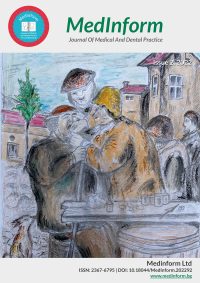Issue Two 2022
2022, Vol. 9, issue 2, (September)
Literature Review
The significance of stress for the development of periodontal disease
Abstract:
The term “stress” is derived from the Latin word “stringere” which means “strained”. Today, stress is classified as a “risk factor” for the development of periodontitis. Stress is seen as a cognitive perception of uncontrollability and/or unpredictability, i.e. expressed in physiological and behavioral response. Therefore, stress can be seen as a process with psychological and physiological components. Already in 1976, Selye defined stress as a state of the body’s reaction to physical and mental forces beyond adaptive capacity, which leads to adaptation diseases and ultimately to exhaustion and death. It recognizes stress factors that act and cause positive changes in the body (e.g. pleasant and positive emotions) leading to a state of response that is defined as “eustress”, or stressors that can be negative and cause sensations, which threaten homeostasis by triggering pain, discomfort and physiological pathology. The author defined the state of negative response as “distress”.
It is known that stress is a response to the action of constant adverse stimuli. At one point or another, every individual can suffer from stress. Stress is compatible with health because it is necessary to cope with the challenges of everyday life. Problems for the individual begin when the stress response is inappropriate to the intensity of the stressor present. Psychological stress can regulate the cellular immune response. Communication between the central nervous system and the immune system occurs through a complex network of two-way signals linking the nervous, endocrine, and immune systems. Stress disrupts the homeostasis of this network, which in turn alters the immune system’s response. The direct link between periodontal disease and stress remains to be proven, partly due to the lack of animal models and the difficulty in quantifying the strength and duration of stress, as well as the presence of many factors influencing the severity of periodontal disease. According to Breivik et al, stress is not what happens to an individual, but how that individual responds to what happens. They define stress as a psychophysiological response of the body to the threat caused by stressors.
Keywords: stress, risk factor, periodontopathogens, cortisol, necrotic-ulcerative gingivitis.
Authors:
Antoaneta Mlachkova; Faculty of Dental Medicine, Department of Periodontology, Medical University, Sofia, Bulgaria;Velitchka Dosseva-Panova; Faculty of Dental Medicine, Department of Periodontology, Medical University, Sofia, Bulgaria;

